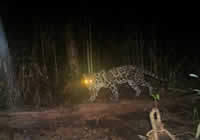Clouded Leopard Found In Borneo
Posted by: Loren Coleman on August 25th, 2008
A new population of rare leopard has been found living in thick forests on the Indonesian half of Borneo island, a researcher has said.
Camera traps in Sebangau National Park in Central Kalimantan province have snapped pictures of two adult male Bornean clouded leopards in an area once decimated by logging, British zoologist Susan Cheyne said. The discovery by researchers from Oxford University’s Wildlife Conservation Research Unit and Indonesia’s Pangkalan Raya University is the first confirmation the clouded leopard, which is classified as vulnerable, lives in the park.
The discovery holds out new hope for the little-understood species, which numbers less than 10,000 individuals and is the top predator on Borneo island, Cheyne said. “This elusive species is a good indicator of forest health. Large cats need prey and the prey — deer, macaques and bearded pigs — need the forest,” she said.
“The clouded leopard is the largest predator on Borneo, there are no tigers. Having the island’s top predator surviving in an ex-logging concession hopefully means that the species is resilient.” However, the discovery still only provides a small amount of information about the behaviour and distribution of the big cats.
“With more time and increased number of photos we can start to identify individual cats, look at which cameras they show up on to get an idea of range, and possible range overlap with the smaller cats,” Cheyne said. The forests on Indonesia’s half of Borneo island are home to some of the world’s most diverse wildlife, but are under threat from plantations and logging, much of it illegal.
Source: Pakistan Daily Times
About Loren Coleman
Loren Coleman is one of the world’s leading cryptozoologists, some say “the” leading living cryptozoologist. Certainly, he is acknowledged as the current living American researcher and writer who has most popularized cryptozoology in the late 20th and early 21st centuries.
Starting his fieldwork and investigations in 1960, after traveling and trekking extensively in pursuit of cryptozoological mysteries, Coleman began writing to share his experiences in 1969. An honorary member of Ivan T. Sanderson’s Society for the Investigation of the Unexplained in the 1970s, Coleman has been bestowed with similar honorary memberships of the North Idaho College Cryptozoology Club in 1983, and in subsequent years, that of the British Columbia Scientific Cryptozoology Club, CryptoSafari International, and other international organizations. He was also a Life Member and Benefactor of the International Society of Cryptozoology (now-defunct).
Loren Coleman’s daily blog, as a member of the Cryptomundo Team, served as an ongoing avenue of communication for the ever-growing body of cryptozoo news from 2005 through 2013. He returned as an infrequent contributor beginning Halloween week of 2015.
Coleman is the founder in 2003, and current director of the International Cryptozoology Museum in Portland, Maine.











Yay! Clouded Leopards are making a comeback!!! WOOHOO!!!
Umm, the last I checked, most leopards were solitary animals. For there to be 2 males within the same area usually means they are probably young, possibly litter mates (not sure how many babies they have). Depending on the area each one takes for its territory, they may only be there because everything else has been taken.
“Depending on the area each one takes for its territory, they may only be there because everything else has been taken.”
No kidding. And not necessarily by leopards.
Hearing pro-industry types crowing about how wrong environmentalists have been – look, there are animals all over the place now! – is, for me, just as annoying as hearing every uptick of one-tenth of a degree anwhere pronounced as global-warming doom on the way. Fact is, humans gobble habitat. Seeing an animal somewhere it hasn’t been before can be good (hey, they’re pretty adaptable!) or bad (hey, they don’t have anywhere else to go).
We don’t know.
Sadly, I have to agree with you. DWA. Still good to see they are still around, though.
Good show.
The wonderful news is that there are still Clouded Leopards out there, anywhere. But if their habitat is not preserved in such a way that they can have adequate territory to live and reproduce, they won’t be there long.
DWA, I also get disgusted when I hear industry types crowing about the animals surviving despite years of hunting and habitat destruction. Where I live, there are ads running all the time, on every channel, extolling the “benefits to wildlife” of mountaintop removal strip mining. The bigshots at the major coal company, which is in turn owned by the world’s biggest oil company, are having a field day. Sadly, now that gas prices have gone so high, I have no doubt that mountaintop removal mining will not only continue, but accelerate.
So very little is known about Clouded Leopards in the wild. Maybe this new evidence will spur some extended field studies. The more that is learned about theirs habits, the more likely it is that programs can be designed to protect them in their own habitat.
Here’s a link to a terrific interview with Dr. Jim Sanderson, a specialist in smaller wild cats, that ties neatly in with this article.
There’s a lot of information about rare cats both large and small, and lots of photos too, including some photos of young “twin” pumas in a jungle (maybe surprising to some people who think of pumas as a temperate North American animal).
I love clouded leopards. I’m fascinated by the ways in which they resemble some ancient types of sabertoothed cats. I saw a trail-cam photo somewhere, a few years back, of a black clouded leopard. I don’t recall where I saw it; it was in a magazine but I have been unable to find it in a google search. I think that one was in Borneo too, but I’m not positive.